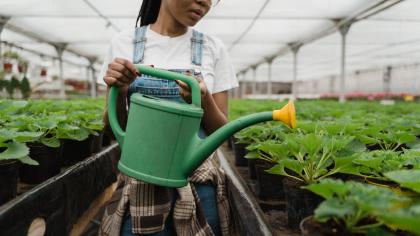Enhance Agricultural Performance With High-Quality Water Soluble Polymers
In the realm of modern farming techniques, the combination of top notch water-soluble polymers has emerged as an appealing method to enhance efficiency and sustainability. These polymers supply a variety of benefits that can change standard farming methods, from boosting water retention and effectiveness to maximizing soil structure and nutrient delivery systems. By harnessing the power of ingenious polymer remedies, farmers can potentially open new pathways towards achieving greater crop yields while mitigating ecological influences. The application of water-soluble polymers holds the potential for transformative changes in agricultural landscapes, making it a topic worthy of further exploration in the world of lasting farming methods.

Benefits of Water-Soluble Polymers
Water-soluble polymers provide a plethora of advantages in agricultural applications due to their boosted water retention buildings and capacity to enhance soil framework. Agriculture. These polymers, when contributed to the soil, can significantly increase water holding capability, minimizing the regularity of irrigation called for by crops. By creating a gel-like compound when blended with water, water-soluble polymers produce a reservoir that gradually launches dampness to plant origins, making sure an extra regular water supply throughout dry spells
Additionally, these polymers help in avoiding soil disintegration by binding soil bits together, thereby enhancing soil structure and security. Improved dirt framework permits for better origin infiltration and aeration, promoting healthier plant growth and greater plant yields. Water-soluble polymers also help in nutrient retention by minimizing leaching, making certain that vital nutrients remain readily available to plants for a longer duration.
Improved Water Retention and Efficiency
Enhancing agricultural water retention and performance through the incorporation of innovative polymer technologies has actually become a critical focus in modern-day farming methods. Water-soluble polymers play a vital duty in enhancing dirt framework, boosting water seepage, and minimizing water dissipation rates. By developing a thin film on the soil surface area, these polymers help to stop water drainage and boost the soil's water-holding capacity, making certain that plants have access to an ample water supply.
Furthermore, the use of top quality water-soluble polymers can significantly reduce the frequency of watering, as they enhance the soil's capacity to keep moisture for longer periods. This not only conserves water however also reduces the power and labor expenses connected with irrigation techniques. Additionally, boosted water retention and effectiveness cause much better nutrient uptake by plants, causing boosted crop yields and overall farming performance.
Boosted Nutrient Distribution Systems
Provided the significant influence of high-quality water-soluble polymers on boosting water retention and effectiveness in agriculture, the emphasis now moves towards optimizing nutrient delivery systems to even more enhance plant development and return. Enhanced nutrient distribution systems play a crucial function in making sure that plants receive the required nutrients in a kind that is conveniently available for uptake, advertising their total wellness and performance. By integrating water-soluble polymers right into nutrient shipment systems, the effectiveness of nutrient uptake by plants can be dramatically improved.
One key benefit of making use of high-quality water-soluble polymers in nutrient shipment systems is their capacity to manage the launch of nutrients, ensuring a regulated and stable supply to plants over an extensive duration (Agriculture). This regulated release system helps stop nutrient leaching and overflow, consequently taking full advantage of vitamins and mineral utilization by crops and minimizing ecological effect

Dirt Framework Optimization Methods
Maximizing soil structure is paramount in modern farming for making the most of plant returns and promoting sustainable land administration practices. Soil framework optimization techniques play a critical role in making certain that soil supplies a perfect atmosphere for plant growth. One crucial technique is the addition of raw material, such as compost or manure, which helps improve dirt structure by improving its water-holding capacity and nutrient retention.
Furthermore, exercising minimal tillage or no-till farming can prevent dirt compaction and advertise the advancement of a healthy and balanced dirt structure. Cover chopping is another efficient strategy that includes growing crops especially to safeguard and enhance the soil, avoiding erosion and boosting dirt framework.
Furthermore, applying plant rotation techniques can help break pest and disease cycles, while also improving dirt structure through the differing root frameworks of various crops. In general, utilizing these dirt structure optimization strategies can lead to more info here increased farming efficiency, minimized environmental effect, and long-term sustainability in farming methods.
Lasting Solutions for Plant Yields

To address the difficulties of making the most of crop returns while advertising lasting land monitoring practices, checking out lasting options ends up being imperative in contemporary agriculture. Applying lasting agricultural techniques is crucial for making sure lasting food protection and environmental conservation. One sustainable remedy for improving plant returns is using accuracy agriculture methods. By leveraging technology such as GPS, sensors, and information analytics, farmers can maximize making use of resources like water, fertilizers, and chemicals, leading to enhanced performance and performance.
Additionally, promoting crop turning and cover chopping can aid keep dirt wellness, reduce disintegration, and boost nutrient cycling, ultimately adding to higher yields gradually. Integrated insect administration approaches also play an essential function in lasting plant production by lessening the dependence on chemical pesticides and promoting natural pest control techniques.
Furthermore, spending in research and advancement for developing drought-resistant crop selections and climate-resilient farming techniques can aid mitigate the effect of climate modification on agriculture while guaranteeing regular yields when faced with environmental challenges. By taking on these sustainable remedies, farmers can accomplish higher crop returns while securing the health and wellness of the land for future generations.
Final Thought
To conclude, making use of high-quality water-soluble polymers in farming offers countless benefits such as improved water retention, improved nutrient delivery systems, and enhanced soil framework. By executing lasting remedies for crop returns, farmers can substantially enhance agricultural performance and performance. Agriculture. Water-soluble polymers offer a cost-effective and eco-friendly method to enhance the general efficiency of farming techniques, leading to better outcomes for both farmers and the environment
These polymers use a range of benefits that can reinvent traditional farming techniques, from boosting water retention and efficiency to enhancing dirt framework and nutrient delivery systems.Furthermore, these polymers assist in preventing soil erosion by binding soil bits with each other, thus boosting dirt framework and stability. By forming a thin movie on the dirt surface area, these polymers aid to prevent water overflow and boost the dirt's water-holding capacity, guaranteeing that plants have i loved this accessibility to an ample water supply.
Dirt framework optimization techniques play a critical role in guaranteeing that dirt gives a perfect setting for plant growth.In final thought, the use of high-grade water-soluble polymers in agriculture uses numerous benefits have a peek at these guys such as better water retention, enhanced nutrient shipment systems, and maximized dirt framework.
Comments on “The Future of Lasting Agriculture: Advancements and Technologies”